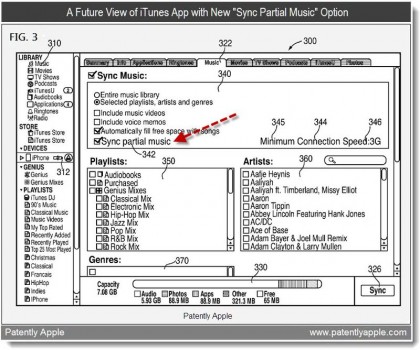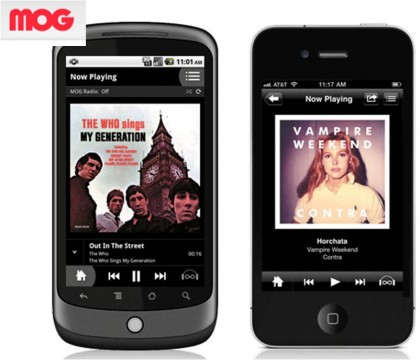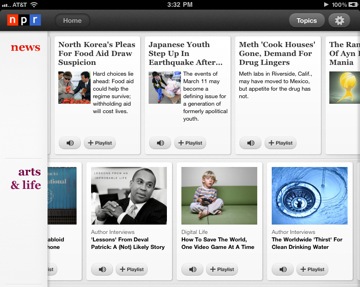In the last decade we’ve seen the launch of the iPod, satellite radio, and streaming music services on the Internet. But as great as those innovations have been, they haven’t always made life easy for consumers. iPods brought with them the inflexible iTunes marketplace and DRM lock-in, satellite radio added in another monthly fee with no music ownership option, and Internet radio requires (shockingly) an Internet connection. The result is that most of us cobble together our own listening system – part CD, MP3, and radio, and entirely dependent on where we are, and what service or hardware we have access to.
Thanks to the cloud, that’s all about to change. In theory, we’ll soon all have access to everything, everywhere we go. And in practice, the shift has already started to take place. Here’s a look at where music is headed.
To the Cloud

It’s been an interesting few months for cloud music services. First, Amazon launched its Cloud Drive service, offering users a space to store digital music files and play them back on the web or Android devices. Then came Google Music, a very similar offering, though one still in invitation-only beta at the moment. And finally, word has circulated in the last week that Apple is set to launch its own music service – with the one critical difference that it’s sewing up licencing deals with the major labels first. With licensing agreements in place, Apple will be able to help users avoid uploading an entire library of music, and instead scan and match any owned titles with copies already available in the cloud.
The thing about all of these cloud services is that their focus is on music storage and playback. That’s great as far as it goes, but it leaves wide open the field of music discovery. Apple could change that with the deals it has in place by introducing a subscription radio service. But as of now, that hasn’t been announced.
On the Radio

As a counterpoint to music locker services, several Internet radio services are also picking up steam. Slacker’s recent on-demand radio application – including professionally-DJ’ed stations – is my favorite example, but it’s certainly not the only option out there. MOG is highly praised for its combination of on-demand music and custom radio streams, and it includes a number of social hooks for learning more about music and sharing with friends. Rdio is relatively new, but it’s working the developer community to create apps that take advantage of a library with 8.5 million songs. Rhapsody has a long tenure with its on-demand subscription service, and it’s pretty widely available across mobile platforms (though Dave’s been frustrated with content availability). And there’s Pandora, which is still a favorite among users who want high-quality audio, custom radio, and a dead-simple interface.
Internet radio appears to be going through another heavy adoption cycle. The combination of availability on mobile devices and caching features for offline playback give these services wider appeal.
Everything Else

Along with cloud services and Internet radio, there’s, well, everything else you could imagine in between the two. Satellite radio is arguably still the best option for more traditional radio lovers, particularly in the car. For news, I’m addicted to NPR’s mobile app, which lets me play radio segments by program, topic, or station location. And new alternative services are launching all the time, like Grace Digital’s DAR.fm, which lets users record and play back popular talk shows on demand.
In short, there’s a solution for almost any type of listening experience you could want. Tying them altogether is where things get tricky. But in the age of the cloud, surely anything’s possible. Right?
I’ve really liked 8tracks.com for music discovery. Anyone can load their own set list and share it for the masses. I’m waiting for an Android app, but they released one for iOS a month or two ago. I found a bunch of ridiculous workout mixes linked from fratmusic.com (don’t ask).
wow!
If anyone’s looking for a Google Music Beta invite, I found a blog giving them out for free. I figured that the waiting list would be too long, so I tried the blog out, and got my invite about an hour later. Nice.
I don’t know if they have any remaining invites, but if you want to try your luck here’s the site:
freemusicbetainvites.com.nu
We have been really impressed with the Amazon cloud music service. In our household of mixed macbooks, netbooks and idevices – the 20 gb of storage has allowed everyone to upload their favorite music to play back anywhere. Pretty neat so far.
Hey guys, if you wanna try one of these out, mog is doing a promotion right now at Mitsubishi.mog.com they’re offering a full month of the service for free, no credit card or commitment. I use it and love it, biggest catalog and best sound quality out of any of them out there!
Mari,
Nice post. I’ve tried various streaming services, but never loved one enough to keep on paying given I’m already paying for Satellite radio in my car. I did have positive experiences with Rdio though, and like the ability to play exactly the song you want unlike Pandora where you can at best circle around the song you want.
Given that I probably have some music in my collection that came from earlier use of Napster back in the day, or even just some albums I got from friends and I don’t know where they got them, I’m nervous about all cloud music services that don’t have air-tight TOS. So I do use Amazon’s cloud service for example, but mostly just for the songs I buy there and children’s music I KNOW I ripped from CD recently. If you read the TOS for Amazon or even Dropbox its clear they’re willing to allow media companies to run checksums on files and look for illegal copies, just not something I want to risk.
Still, its surprising how poor the music players available for iOS for various cloud services are. Carbonite? One track at a time. Dropbox? One track at a time thru the native player, and all the iOS apps that tie into the APIs are garbage. Either they don’t understand metadata, or they can’t navigate folders, or … don’t get me started. Plus I’ve got probably 80GB of music on my desktop, and that’s way more than most cloud services want to give you storage for.
So given what a great experience I’ve had with Air Video, I started looking at streaming apps that streamed your music from your home computer. I would have used Simplify, but of course Google bought them and the app isn’t available through the iOS app store anymore. I settled on iSub which is a client for Subsonic, an open source server available for Windows & Mac. It works VERY well actually. Quite impressed.
Given the pace of change in this space, I’ll probably have to keep watching, and will reanalyze my choice in 6 months or so. I’ll certainly look at whatever Apple makes available, and if Amazon as expected eventually comes up with an iOS app I certainly look at that. The web interface just isn’t going to cut it, though its certainly better than nothing.
“So given what a great experience I’ve had with Air Video, I started looking at streaming apps that streamed your music from your home computer”
Give Plex a look-see.
Server runs on OS X and Windows. Client runs on iOS and Android. Streams your iTunes music library, as well as your Plex video library.
It has applicable data. Thanks for posting this. Your blog is so intriguing and very informative.